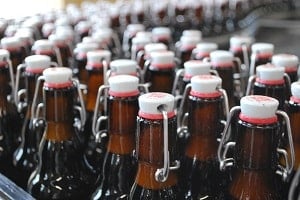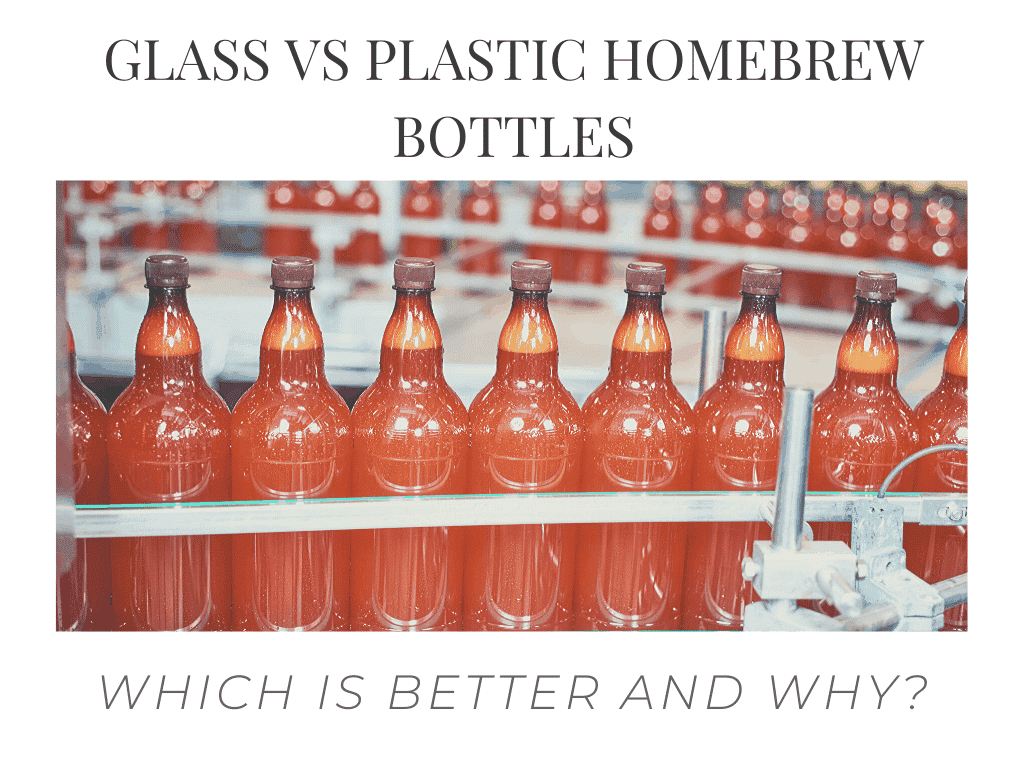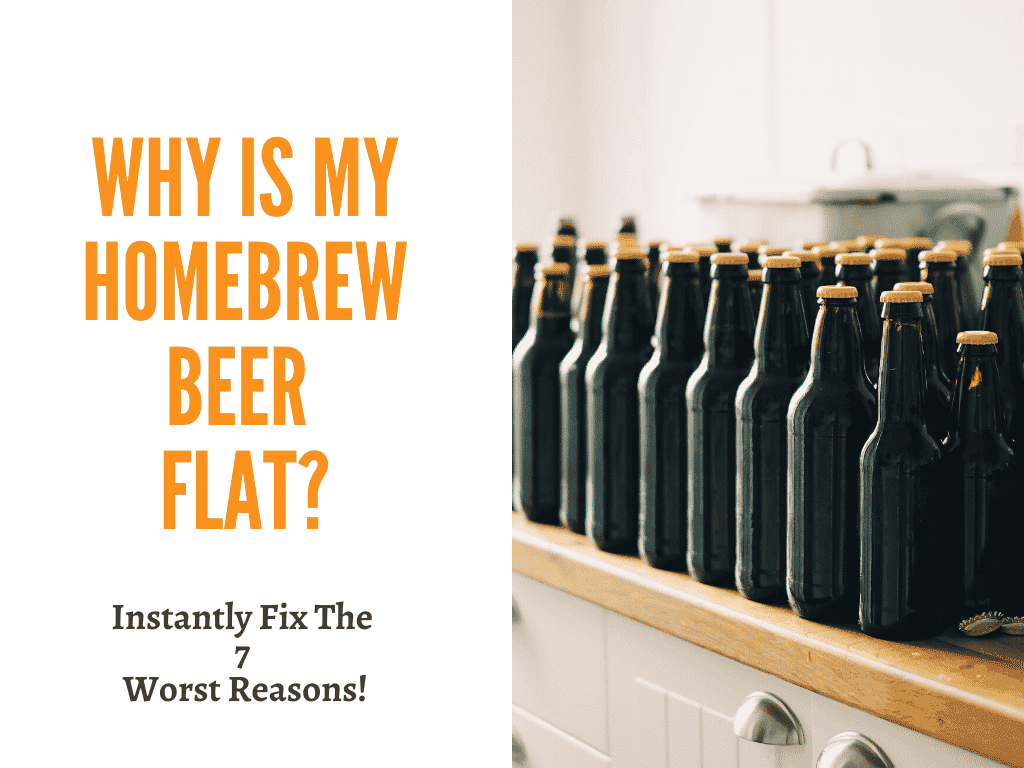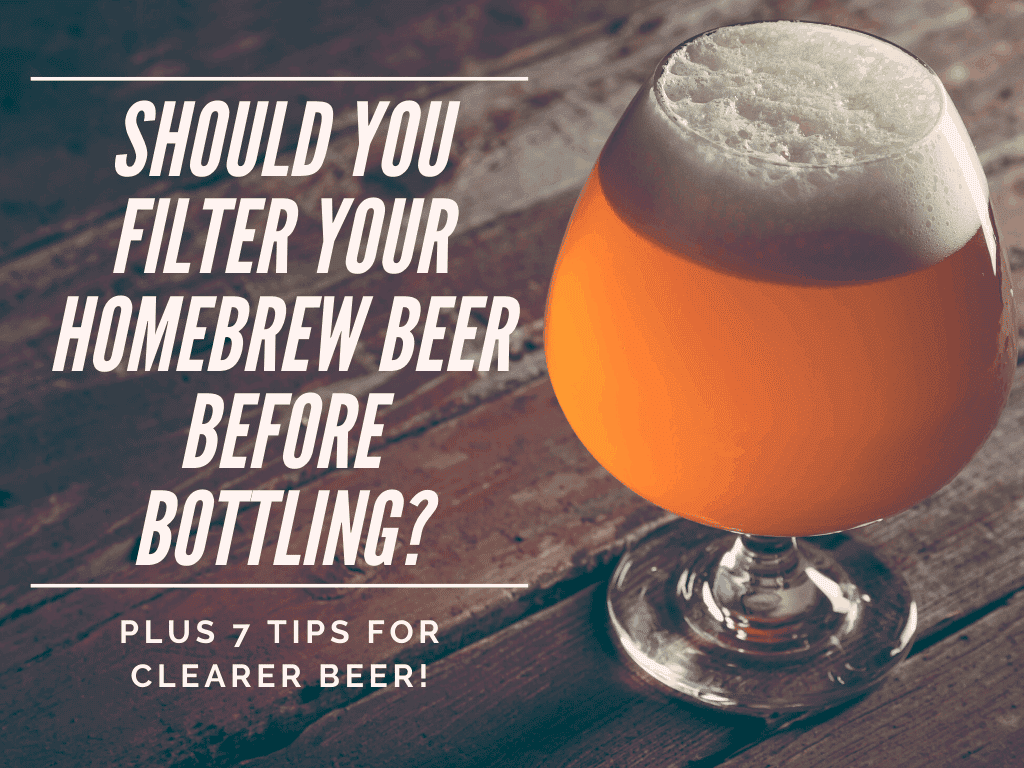While many beer makers carbonate their beer with force carbonation, bottle conditioning beer not only produces a comparable level of carbonation but is also an essential way to develop balanced flavor for many styles of beer. Though the specifics of how long to bottle condition a batch depends on a number of factors, there are some general rules of thumb that will help you make the best possible naturally carbonated beer.
Homebrewers should bottle condition their beer for 1-3 weeks at room temperature and then let it sit in the fridge for at least 48 hours before drinking it. Stronger, more complex beers benefit from longer bottle conditioning time, from several weeks to several months. Hoppy beers like IPAs should be enjoyed as soon as the bottle is carbonated.
Read on to learn more about bottle conditioning your beer and to understand why many beers improve over time!
Topics We Cover
How long should you bottle condition homebrew beer?
Bottle conditioning may be a complex process, but when you understand the factors at play you will be able to accurately predict how long to bottle condition any beer you brew.
Some beers are best enjoyed just two weeks after bottling, while others are conditioned for several years before being popped open.
Let’s take a look at the most important factors to consider when bottle conditioning your beer:
- Temperature
- Priming Sugar
- Desired Carbonation
- ABV
- Style of Beer
Temperature
Temperature affects fermentation in a fairly straightforward way; the higher the temperature, the faster the fermentation.
Bottle carbonation is usually done at room temperature to allow for the carbon dioxide to completely saturate the beer as fast as possible. By carbonating your beer quickly, you ensure that any remaining oxygen is scrubbed from each bottle for a delicious and shelf-stable beer.
While high-temperature fermentation is much more efficient, it can also produce some off-flavors, however, so many styles of beer are further conditioned at much cooler temperatures in a process known as “lagering.”
Priming Sugar
When choosing a priming sugar, it’s important to recognize that different sugars are metabolized at different rates.
It will take much longer for yeast to completely ferment complex sugars like honey than simple sugars like dextrose. This difference in fermentation time is the main reason why corn sugar is one of the most popular options for priming sugar.
Although you can still use complex sugars for bottle conditioning you will have to factor in quite a bit of additional time for your beer to become fully carbonated, and even more, before it is completely conditioned.
Desired carbonation
The amount of saturated carbon dioxide expected for each specific style of beer will also affect the amount of time needed to fully bottle condition each batch.
Highly-carbonated bubbly beer will need a bit longer to fully carbonate than a less effervescent style.
Beer that requires a higher volume of carbonation will use more sugar which will, in turn, take longer for your yeast to fully metabolize. Highly saturated styles may also require fermentation at lower temperatures to allow the carbon dioxide to fully saturate your beer, which may also increase the expected turnaround on bottle conditioning.
Alcohol content
Fermentation is always more efficient in lower concentrations of alcohol, even for yeast bred specifically for high alcohol tolerance.
Carbonation and conditioning will take significantly longer for high-alcohol beer than for a batch with a lower ABV. While session beers under 5% ABV can fully carbonate in a week or less, anything over 8% will usually need at least 4 weeks to fully carbonate.
When it comes to lagering or cold conditioning your beer after carbonation, the difference in alcohol content becomes even more apparent:
- Light beer – Most light lagers only require 3-4 weeks to fully condition after carbonation.
- Dark beer – Many dark, high ABV beers need at least four to six months to mature, with some claiming two or more years of conditioning are needed to fully develop the complex flavors desired.
Style of Beer
Simultaneously the most important and the most subjective aspect of bottle conditioning, flavor is an essential factor to consider when conditioning your beer.
Longer conditioning times will result in the crisp, complex, and well-balanced character seen in styles from light lagers to imperial stouts. On the other hand, less time in the bottle makes for a more aromatic, headier flavor profile perfect for IPAs, wheat beers, and some ales.
While there are endless styles of beer, the main flavor categories to consider when bottle conditioning beer are:
- Aromatic beers, including hop-forward ales and beer known for characteristic esters;
- Clean and crisp beers, from traditionally lagered beer like kolsch to sours; and
- Complex dark beers, like porters, stouts and tripels.
Aromatic beers
This category includes IPAs, wheat beer, and any beers famous for their strong aromatic flavor profiles or bitterness. Not only do volatile aromatic compounds degrade over time, but the aging beer can also reduce the bitterness and roastiness sought after in some aromatic beers.
Because of their short-lived volatile flavors, aromatic beers should be enjoyed as soon as they are carbonated to enjoy their unique characteristics.
Don’t rush carbonation though: carbon dioxide can help heighten these flavors, so under-carbonating your beer will do as much harm as conditioning it too long.
Clean and crisp beers
Unlike aromatic beers, lagers and sours are known more for their crisp flavor than for their volatile aromatic compounds. Cold conditioning these beers can break down lactic and acetic acids into fruity esters, mellow out fusel alcohol, fruity, or buttery off-flavors, and cut down on residual sugars for a crisper beer.
By giving light lagers and sours about three weeks to a month to bottle condition, you will achieve a much crisper and more well-balanced flavor profile.
Complex dark beers
Imperial stouts, Belgian ales, English porters, and other dark, yeasty, and malt-forward beers will require the longest amount of time to fully develop their characteristic flavors during bottle conditioning.
These “big” beers get most of their character from dark, complex flavors that would rarely be described as bitter, fruity, or heady. Rather, these types of beers will only improve over time as their flavors mellow out and mingle together.
In addition, these beers will continue to develop a luscious, nutty caramel character as the Maillard reaction slowly progresses over time.
How long should I bottle condition my homebrew beer?
Now that we’ve discussed all the factors that affect how long you should bottle condition your beer, let’s try and apply that information and make some practical determinations.
Take a look at this chart below and try to match what you learned about fermentation times and conditioning onto the expected time needed for each style of beer!
| Beer Style | How Long to Carbonate | How Long to Bottle Condition |
|---|---|---|
| Pale Ale | 2-3 weeks | 0+ weeks |
| IPA | 2-3 weeks | 0 weeks* |
| Imperial IPA | 4+ weeks | 0 weeks* |
| Stout | 2-3 weeks | 3-4+ months |
| Imperial Stout | 4+ weeks | 4-6+ months |
| Porter | 2-3 weeks | 3-4+ months |
| Hefeweizen | 2-3 weeks | 0 weeks* |
| Saison | 2-3 weeks | 0+ weeks |
| Belgian Tripel | 4+ weeks | 4-6+ months |
| Kolsch | 2-3 weeks | 3-4+ weeks |
| Lager | 2-3 weeks | 3-4+ weeks |
How do you know when bottle conditioning is done?
As mentioned above, bottle conditioning has two main components: carbonation and conditioning.
While there are a few tricks to identify when a beer is carbonated, the only real way to know whether a beer is finished conditioning is to crack open a sample and trust your palate.
If you are unsure whether your beer is finished carbonating, there are a few tricks that will help you identify a properly carbonated beer without ever having to uncap a bottle. For a recap, some of the best ways to check carbonation levels are:
- Sediment – Because carbonation is basically another short round of fermentation, you can keep an eye out for sediment building up at the bottom of your bottles to clue you in to the yeast’s progress.
- Carbonation – You can also try turning a bottle over to look for small carbonation bubbles rising up the side of the glass.
- The raisin trick – If you’re nervous about sugar levels and you want a really obvious sign that it’s time to fridge your beer before they over carbonate, you can even put a raisin in one of your bottles; once the bottle carbonates, the raisin will rise to the top.
If you’ve overcarbonated your beer, check out this resource for how to salvage those bottles!
However, when it comes to checking the flavor development of a batch of beer, the only way to check on its progress is to crack one open and give it a taste!
Trust your palate: if the beer tastes well balanced and pleasant, they’re ready to drink. If you notice any off-flavors, you’re best off letting the rest of your batch sit another week before taking another sample.
While many off-flavors will be pretty obvious. But depending on the style of beer, some flavors to remember that might suggest an under-conditioned beer include:
- Fusel alcohols
- Buttery or butterscotch flavor
- Fruity aromas, including green apple or banana
- Sour or vinegar-like acidity
- High bitterness
How long to bottle condition Pale Ales
ABV Range: 4.4 – 6.6%
Hop Bitterness (IBU): 5 – 12
Desired Dissolved CO2: 2.2 – 2.8
Session ales under 5% will usually carbonate within a week at room temperature, though two to three weeks is considered the sweet spot. Pale Ales rarely need to be conditioned for longer than it takes for them to carbonate, but lagering them for a few weeks can balance out any potential off-flavors.
Since pale ales have a relatively low alcohol content, they will carbonate and condition within a few weeks. Since the ideal flavor profile of a pale ale includes malt and a light hoppy aroma, there’s no need to bottle condition this style for long.
But if you notice unpleasant aromatic flavors, or just prefer a maltier ale with more balanced hops, feel free to let this style develop in your fridge for a few weeks before serving.
How long to bottle condition IPAs
ABV Range: 3.7 – 5.0%
Hop Bitterness (IBU): 30 – 55
Desired Dissolved CO2: 2 – 2.5
Session IPAs will carbonate within two to three weeks at room temperature. Once the carbon dioxide has completely saturated your beer, you should drink your IPA sooner than later to enjoy the characteristic hoppy bitterness of the style.
While hoppy aromas will certainly fade over time, it is important not to under-carbonate your IPAs. Carbonation will help carry those resinous and citrusy aromas across your palate, so don’t be discouraged if it takes the full three weeks for the flavors in your IPA to express themselves.
While bottle conditioning IPAs is certainly an option, brewers who enjoy making this style might be better off investing in a kegging setup. Not only does bottle conditioning risk exposing your IPA to oxygen and blunting the hoppy aromas, but it will also cause your ale to fade into an unappetizing brownish-gray. Bottle conditioning is great for certain styles, but there’s a good reason why many modern IPAs are force carbonated.
How long to bottle condition Imperial IPAs
With ABVs rising upwards of 8%, you should expect imperial IPAs to take at least a month to fully carbonate.
This style is susceptible to many of the same problems with bottle conditioning as session IPAs, so if you choose to bottle condition an imperial make sure to use an easily metabolized priming sugar and let your beer ferment at or above room temperature.
How long to bottle condition Stouts
ABV Range: 4.1 – 4.3%
Hop Bitterness (IBU): 30-40
Desired Dissolved CO2: 1.8 – 2.5
Stouts should be completely carbonated within two weeks of bottling at room temperature. However, a generous conditioning period of three to four months is recommended to develop a well-balanced flavor free of volatile aromatics.
While stouts will carbonate quickly due to their low alcohol content and minimal carbonation, they will improve with a longer conditioning to highlight the sweet malty flavors.
How long to bottle condition Imperial Stouts
High alcohol imperial stouts can range all the way up to 12% ABV and thus require significantly longer to carbonate and condition.
Expect at least four months for complete carbonation and anywhere from four months to over a year for the most complex and well-balanced finish possible.
How long to bottle condition Porters
ABV range: 4.4 – 6.0%
Hop Bitterness (IBU): 20-30
Desired Dissolved CO2: 1.8 – 2.5
Porters, like stouts, require little time to fully carbonate but will improve drastically with a longer conditioning period. Three to four months after the two or three weeks for carbonation should be sufficient.
How long to bottle condition Hefeweizens
ABV Range: 4.9 – 5.6%
Hop Bitterness (IBU): 10 – 15
Desired Dissolved CO2: 2.4 – 2.9
Hefeweizens will need about two to three weeks to fully carbonate. From there, they are best enjoyed fresh while the characteristic aromas of this style remain active.
As a wheat beer, hefeweizens are known for their characteristic fruity, spicy, and banana-like esters. These volatile aromas will diminish quickly with time, so the sooner you drink your hefeweizen, the better.
How long to bottle condition Saisons
ABV Range: 5.0 – 6.8%
Hop Bitterness (IBU): 20 – 38
Desired Dissolved CO2: 2.3 – 2.9
Similar to hefeweizens, saisons are known for their unique aromas and require little bottle conditioning. While carbonation may take slightly longer to account for the increased alcohol content, two to three weeks will usually do the trick.
While saisons are usually enjoyed fresh, their flavor profile is more forgiving to bottle conditioning. So if you find that your saison has strong off-flavors or is generally unbalanced, a week or two of lagering can help improve the flavor while leaving behind most of the distinctive flavors associated with the style.
How long to bottle condition Belgian Tripels
ABV Range: 7.1 – 10.1%
Hop Bitterness (IBU): 20 – 45
Desired Dissolved CO2: 2.4 – 3.0
Due to their exceptionally high alcohol content, Belgian tripels will take a very long time to carbonate and complete their conditioning. You will probably need at least a month to fully carbonate a bottle and anywhere from 4 months to upwards of a year for a completely balanced beer.
The longer you leave a tripel in its bottle, the more balanced and complex its flavors will become. Through a combination of Maillard reaction, breakdown of volatile flavors. and relaxing of proteins, tripels with long conditioning times can provide an incredibly rich flavor profile. Once at about four months, you can begin sampling bottles until you reach perfection.
How long to bottle condition a Kolsch
ABV Range: 4.8 – 5.3%
Hop Bitterness (IBU): 22 – 30
Desired Dissolved CO2: 2.4 – 2.8
Famous for its crisp, clean flavor, the Kolsch is a style famously associated with lagering. While two to three weeks should be sufficient for full carbonation, further cold conditioning from between two and four weeks is best.
During the lagering process, Kolsch will develop both a more balanced flavor and a crystal clear color thanks to the precipitation of proteins during bottle conditioning.
How long to bottle condition Lagers
ABV Range: 4.1 – 5.1%
Hop Bitterness (IBU): 5 – 15
Desired Dissolved CO2: 2.5 – 2.8
Though lager and Kolsch are brewed differently, the finishing process looks almost identical. For a similar clean, crisp finish, you will want to carbonate your lager for two to three weeks before cold conditioning it for three to four weeks in the refrigerator.





